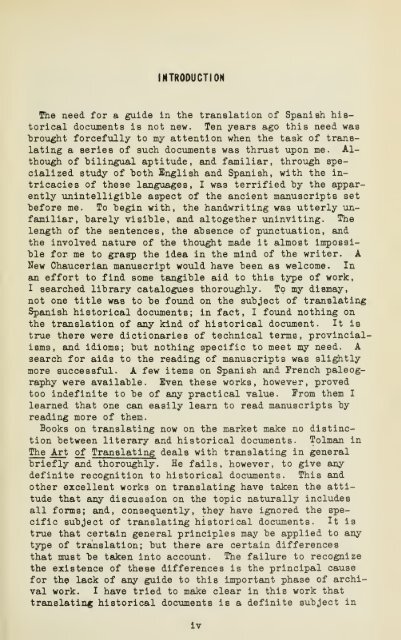Handbook for translators of Spanish historical ... - University Library
Handbook for translators of Spanish historical ... - University Library
Handbook for translators of Spanish historical ... - University Library
You also want an ePaper? Increase the reach of your titles
YUMPU automatically turns print PDFs into web optimized ePapers that Google loves.
INTRODUCTION<br />
The need <strong>for</strong> a guide in the translation <strong>of</strong> <strong>Spanish</strong> <strong>historical</strong><br />
documents is not new. Ten years ago this need was<br />
"brought <strong>for</strong>cefully to my attention when the task <strong>of</strong> translating<br />
a series <strong>of</strong> such documents was thrust upon me. Although<br />
<strong>of</strong> bilingual aptitude, and familiar, through specialized<br />
study <strong>of</strong> both English and <strong>Spanish</strong>, with the intricacies<br />
<strong>of</strong> these languages, I was terrified hy the apparently<br />
\inintelligi'ble aspect <strong>of</strong> the ancient manuscripts set<br />
"be<strong>for</strong>e me. To "begin with, the handwriting was utterly unfamiliar,<br />
"barely visi"ble, and altogether vminviting. The<br />
length <strong>of</strong> the sentences, the a'bsence <strong>of</strong> punctuation, and<br />
the involved nature <strong>of</strong> the thought made it almost impossible<br />
<strong>for</strong> me to grasp the idea in the mind <strong>of</strong> the writer. A<br />
New Chaucerian manuscript would have been as welcome. In<br />
an ef<strong>for</strong>t to find some tangible aid to this type <strong>of</strong> work,<br />
I searched library catalogues thoroughly. To my dismay,<br />
not one title was to be foxind on the subject <strong>of</strong> translating<br />
<strong>Spanish</strong> <strong>historical</strong> documents; in fact, I found nothing on<br />
the translation <strong>of</strong> any kind <strong>of</strong> <strong>historical</strong> document. It is<br />
true there were dictionaries <strong>of</strong> technical terms, provincialisms,<br />
and idioms; but nothing specific to meet my need. A<br />
search <strong>for</strong> aids to the reading <strong>of</strong> manuscripts was slightly<br />
more successful. A few items on <strong>Spanish</strong> and French paleography<br />
were available. Even these works, however, proved<br />
too indefinite to be <strong>of</strong> any practical value. From them I<br />
learned that one can easily learn to read manuscripts by<br />
reading more <strong>of</strong> them.<br />
Books on translating now on the market make no distinction<br />
between literary and <strong>historical</strong> documents. Tolman in<br />
The Art <strong>of</strong> Translating deals with translating in general<br />
briefly and thoroughly. He fails, however, to give any<br />
definite recognition to <strong>historical</strong> documents. This and<br />
other excellent works on translating have taken the attitude<br />
that euay discussion on the topic nat\irally includes<br />
all <strong>for</strong>ms; and, consequently, they have ignored the specific<br />
subject <strong>of</strong> translating <strong>historical</strong> documents. It is<br />
true that certain general principles may be applied to any<br />
type <strong>of</strong> tra!nslation; but there are certain differences<br />
that must be taken into account. The failure to recognize<br />
the existence <strong>of</strong> these differences is the principal cause<br />
<strong>for</strong> the lack <strong>of</strong> any guide to this important phase <strong>of</strong> archival<br />
work. I have tried to make clear in this work that<br />
translating <strong>historical</strong> documents is a definite subject in<br />
iv










![Novellen [microform] - University Library](https://img.yumpu.com/21939450/1/171x260/novellen-microform-university-library.jpg?quality=85)
![Anecdota Chisiana de re metrica [microform]](https://img.yumpu.com/21939448/1/190x239/anecdota-chisiana-de-re-metrica-microform.jpg?quality=85)



![Schollenbruch [microform] : Gedichte - University Library](https://img.yumpu.com/21939437/1/174x260/schollenbruch-microform-gedichte-university-library.jpg?quality=85)

